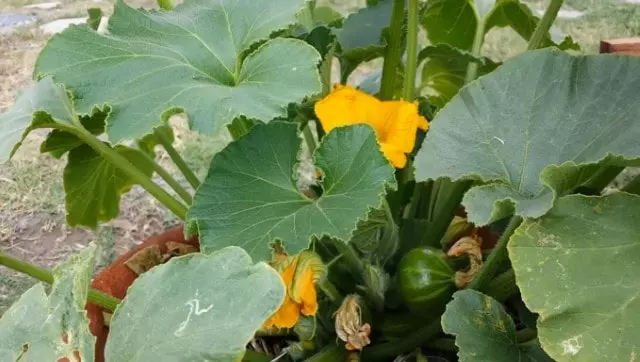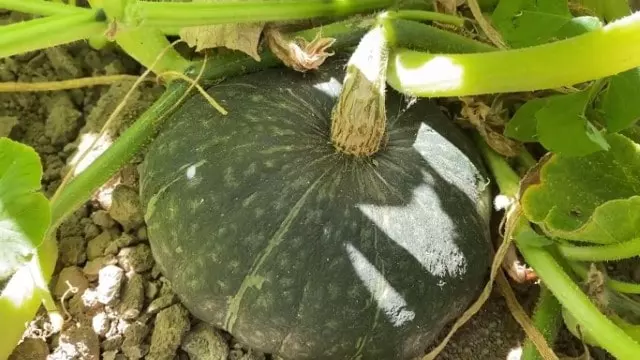Kabocha squash is a winter squash that was developed in Japan and is widespread throughout the world. The fruits of the Kabocha squash weigh between 2 and 3 pounds (900 grams and 1400 grams). This article summarizes the Kabocha squash days to maturity. However, you may have purchased a squash seedling from a nursery and therefore do not know the number of days remaining in the crop. So, How to tell if Kabocha squash is ripe? Don’t worry. You will learn How and when to harvest Kabocha squash. How to pick and store Kabocha squash.
The fruits of Kabocha squash are not as big as other winter squash varieties, but the plant needs space to develop. Kabocha squash is very famous for its sweet taste and texture. Usually, people compare its taste with sweet potato and pumpkin.
Table of Contents
When to Harvest Kabocha Squash
When to Harvest Kabocha Squash? Kabocha squash is ready to be harvested after 50 to 55 days of fruit set. Watch the fruit on the vine with attention in the final days of ripening to harvest them on time. Normally, you will begin harvesting Kabocha squash in late summer and early fall.
Also, look at the skin of the Kabocha squash to see if the fruit is ripe. Press with your fingernail on the skin of the Kabocha squash, it should not leave a mark on the skin of the squash. If your fingernail leaves a mark, it means that the squash is not ripe yet. Ripe winter squash will have hard skin.
Kabocha squashes usually weigh between 2 and 3 pounds (900 grams and 1400 grams), which is another clue whether the fruits are ripe. As the Kabocha squash matures, you will notice that the vine begins to dry out.
Not all Kabocha squash will be ripe at the same time, only harvest the ripe ones. Once harvested, Kabocha squash will not continue to ripen off the vine. Harvest all Kabocha squash before frost to avoid frost damage to the squash.
Therefore, to know when to harvest Kabocha squash you should observe the skin of the squash, the size, and the days of ripening of the fruit. Harvesting Kabocha squash at the right time will provide excellent and tasty fruits.

Kabocha Squash Days To Maturity
Kabocha squash usually takes approximately 50 to 55 days to reach maturity after being planted from seed. The specific time to maturity can vary depending on the variety of kabocha squash and the growing conditions. Nevertheless, suppose you obtained a squash seedling from a nursery. In that case, you might not know the remaining days until the crop matures. Don’t worry; here is how to tell if Kabocha squash is ripe.
How To Tell If Kabocha Squash Is Ripe
Kabocha squash should be picked when it has fully matured and reached its optimal ripeness. The timing for harvesting kabocha squash depends on the growing conditions. Still, it typically occurs around 55 to 60 days after planting from seed (which refers to the Kabocha squash days to maturity). However, you may have purchased a squash seedling from a nursery and therefore do not know the number of days remaining in the crop. So, How To Tell If Kabocha Squash Is Ripe?
Like other winter squash types, kabocha squash is best harvested when fully matured. A ripe kabocha squash typically has a deep, rich color. The green color should be consistent and uniform across the entire surface of the squash. As kabocha squash ripens, the skin’s glossy appearance tends to dull, becoming less shiny than when it was immature. Also, you will notice the squash will reach its full size and have a uniform shape. When it is not mature might be smaller or have an irregular shape.
When To Pick Kabocha Squash
When To Pick Kabocha Squash. When the squash is ripe, the skin becomes hard and tough. Gently press your fingernail against the skin of the kabocha squash. If the skin is hard and resists puncturing, it signifies maturity. A ripe kabocha squash should have a tough outer skin that protects the flesh inside. Also, check the stem where it connects to the squash. A mature kabocha squash will have a thicker and more woody stem than an immature one.
If you know the approximate number of days since the kabocha squash was sowed, which has been around 50 to 55 days, it is likely mature and ready for picking.
As with any squash, harvesting kabocha before the first frost in colder regions is essential to avoid damage and storing them properly to extend their shelf life.
How to Pick Kabocha Squash
Before you start, gather a sharp knife or pruning shears for cutting the squash from the vine. Also, have a container or basket ready to collect the harvested squash. Scrutinize the kabocha squash to ensure it is fully mature and ready for harvest before picking it.
How to Pick Kabocha Squash? Harvesting Kabocha squash is not difficult. The first thing you need to harvest Kabocha squash is a sharp knife or pruning shears to cut the stem, leaving a short stem attached to the fruit. Disinfect the tools you will use to pick the squash with alcohol. Be careful not to damage the squash during the harvesting process.
Select only mature Kabocha squash. Remember that Kabocha squash does not ripen off the vine. Once you’ve confirmed that the kabocha squash is ripe, cut it from the vine. Position the knife or pruning shears close to the stem. Cut the Kabocha squash, leaving a 1” to 2” (2.5 to 5 cm) stem for better storage. It is essential to leave some of the stem in the squash to store it better and longer. Be gentle to avoid any damage to the squash. If dirt or debris is on the kabocha squash’s surface, gently brush it off.
Be sure to harvest all Kabocha squash before the frost begins. Watch the vine daily for new squash that is ripe and ready to harvest.
- Brand:CaribbeanGarden, Country Of Manufacture:United States
- Model:Cucurbita moschata
- Mpn:Pumpkin/Squash
After picking, place the kabocha squash in a cool, dry place. If you plan to store it for an extended period, ensure the storage area has good ventilation to prevent mold growth. Properly stored, kabocha squash can last several weeks to a few months. Storing kabocha squashes in a cool and dry place will preserve their quality and prolong their shelf life.
How to Store Kabocha Squash
How to Store Kabocha Squash? To store Kabocha squash, you must cure the squash as with all winter squashes. If the squash is to be consumed in the next few days, curing is not necessary, but curing improves the flavor of the squash.
To cure the Kabocha squash, place the squash (without stacking) in a place with good ventilation and without the risk of the squash getting wet due to rain. The ideal curing temperature for Kabocha squash is between 80 and 85 °F (27 to 29 °C). The curing process of Kabocha squash takes approximately 10 to 15 days.
Once the curing process is complete, you can store your Kabocha squash (without stacking) for several months. You can store Kabocha squash in a garage with a temperature of 50 and 55 °F (10 to 13 °C). According to the University of California, Kabocha squash can be stored for 2 to 6 months.
The Sunshine Kabocha squash variety is more flavorful if consumed immediately after harvest without curing the squash. The rest of the Kabocha squash varieties need curing to obtain a better flavor.

Final Conclusions about When to Harvest Kabocha Squash
Kabocha squash has become very popular in recent years, and it is widespread to see this variety of squash in different gardens and dishes. To prepare delicious dishes, we usually plant Kabocha squash in our garden for its flavor and texture.
When the fruit develops a deep, rich color and the skin and stem become hard, it indicates it is ready for picking.
If you’re uncertain about the maturity of the kabocha squash, it’s better to wait a little longer to ensure it’s fully ripe. Harvesting squash too early can lead to poor flavor and texture. Once harvested, store kabocha squash in a cool, dry place to preserve its quality and extend its shelf life.
Following these steps, you can pick kabocha squash at the right time and ensure they remain in good condition for consumption or storage. I hope this article about how and when to harvest Kabocha squash will be of great help and that you will have an excellent harvest. I recommend our articles about when to harvest Delicata squash and when to harvest Pattypan squash.


